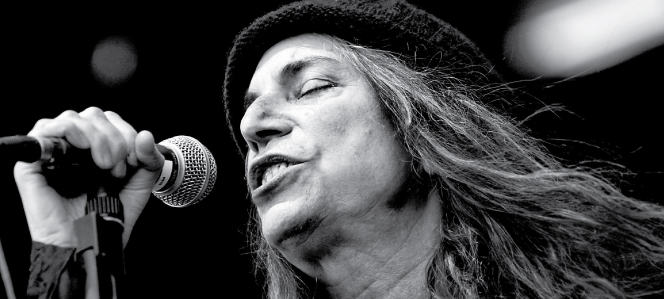Perhaps it was an envious curiosity that led me to read Patti Smith’s memoir, Just Kids. The National Book award winning memoir from a Rock and Roll Hall of Fame member – whose album Horses is considered one of the top albums of all time and who has also been awarded the title of “Commandeur des Art et des Lettres” by the French Ministry of Culture (which, with all due respect to Jerry Lewis, means that she really is something of a genius in France.) So, yes, it wasn’t just admiration for another Smith that led me to this book. (Seeing that she was born on the north side of Chicago and my father was a Smith on both sides of his family, the odds may be good that we are some sort of third cousins…) And I’ve never been a great fan of her music. But I just had to know the back story on someone who was so “award winning.”
I felt an immediate kinship with the young Patti, a girl enthralled by prayer, books, and the tangible symbols of the spiritual life. “I had a secret compartment near my bed, beneath the floorboards. There I kept my stash – winnings from marbles, trading cards, religious artifacts I rescued from Catholic trash bins: old holy cards, worn scapulars, plaster saints with chipped hands and feet.” [1]
As a twelve year old she watched The Song of Bernadette and was confronted by the meaning of vocation. She felt a calling to art but worried about its validity. “This worried me. I wondered if I had really been called as an artist. I didn’t mind the misery of a vocation but I dreaded not being called.” [2] Her family was not well off, but she writes of a childhood that was culturally rich and nourishing to her artistic inclinations. So young and already so thoughtful and aware of the “divine spark” that Pope John Paul II referred to in his Letter to Artists in 1999: “Those who perceive in themselves this kind of divine spark which is the artistic vocation—as poet, writer, sculptor, architect, musician, actor and so on—feel at the same time the obligation not to waste this talent but to develop it, in order to put it at the service of their neighbour and of humanity as a whole.”
The jump to young starving artist did not come easily. Her college days were ended by pregnancy and a baby given up for adoption. The poetic and artistic world of her imagination sustained her until she could scrape together a small amount of money to go to New York and embark upon what she now strongly took as a vocation. Though she was lacking in anything along the lines of a step-by-step “life plan” and living on the most basic subsistence level, life continued to unfold in a fascinating way, including her pivotal meeting of and bonding with a young, unknown Robert Mapplethorpe.
Here is where I wish to express my ambivalence about admitting admiration for this book. Why ambivalence? It’s a pride thing. And when we are so often judged by what we are not (the books we won’t read, the movies we won’t see, the Chinese-made lead-laden cartoon-promoting products we won’t buy) there is the temptation – at least there is for me – to be less than honest. This temptation is not from any innate goodness – it screams “I want you to like me. Look – I’m a good Catholic/mother/consumer just like you.” It is time to move beyond that; to admit that there are places we can explore that may not appear to be edifying in a more traditional sense but yield some definite spiritual truths.
Patti Smith has given us a rare opportunity to see the growth of two youthful artistic souls and their differing responses to the offers of grace in their lives. I certainly am not writing this to canonize, lionize or even attempt to rationalize Mapplethorpe’s most notorious work. As his photography evolved there was much that even Patti – who was his “soul mate,” for want of a better description – could not bear to look at. In her eyes “the artist and hustler was also the good son and altar boy” [3]. But it was very early in their relationship that Patti knew the divide that Robert was crossing. She would take lunch breaks spent in prayer at St. Patrick’s. She would pray for the dead. And pray for herself and Robert. “We were both praying for Robert’s soul, he to sell it and I to save it.”[4]
Just Kids is much more than just another ‘good altar boy gone bad’ tale. It is, as I anticipated, a look into the rarefied atmosphere of the New York art scene of the 1970s. But more unexpectedly I found a touching protopunk spiritual memoir. We are not only shown Robert’s acquiescence to the allure of evil, but also a witness to genuine friendship and love. Love that bears, hopes and believes all things. As Robert Mapplethorpe approached death from AIDS in 1989, “He had tried everything from science to voodoo, everything but prayer. That, at least, I could give him in abundance. I prayed ceaselessly for him, a desperate human prayer. Not for his life, no one could take that cup from him, but for the strength to endure the unendurable.” [5] For those who can look beyond the sex and drugs and rock and roll, this is a thought provoking story.
[1] Patti Smith, Just Kids (New York, New York, Ecco, 2010) p.7.
[2] Ibid., p. 12
[3] Ibid p. 188
[4] Ibid p. 63
[5] Ibid p. 275
